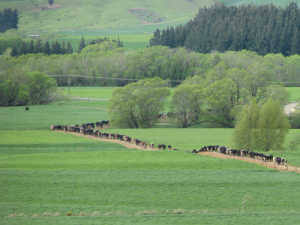Wired for Science: Understanding the feeding habits of mealybug
Fussy children might be frustrating, but fussy mealybugs could help protect the New Zealand wine industry from grapevine leafroll-associated virus 3.
 Hafiz M. Abrar Ilyas is comparing the difference between Pastoral Dairy Farms and Confined Animal Feeding Operations dairy systems in terms of energy consumption and environmental emissions.
Hafiz M. Abrar Ilyas is comparing the difference between Pastoral Dairy Farms and Confined Animal Feeding Operations dairy systems in terms of energy consumption and environmental emissions.
A Lincoln University PhD student is putting New Zealand’s vaunted paddock-based dairy industry to the test.
Hafiz M. Abrar Ilyas is comparing the difference between Pastoral Dairy Farms (PDFs) and Confined Animal Feeding Operations (CAFOs) dairy systems in terms of energy consumption and environmental emissions.
He says it is something that has not been done before but needs to be looked at if New Zealand is to take its environmental responsibilities seriously.
“Pastoral Dairy Farming Systems are common in New Zealand while the CAFO system is relatively new, but increasing in numbers especially in the South Island,” he says.
“The core advantage of using CAFOs system is that they have minimum soil disturbance, have more control over climate events and research has shown they can achieve higher milk production per cow.”
However, are they more energy efficient and able to reduce emissions?
A direct comparison will let the numbers speak for themselves.
“The intensification of New Zealand’s dairy industry, including its vertical and horizontal expansion could cause serious environmental issues,” Ilyas says.
New Zealand’s agriculture sector produces 46% of its greenhouse gas emissions, according to a 2014 Ministry for the Environment report.
Dedicated efforts and studies are required to look into the environmental impact the dairy industry is having on New Zealand, he says.
“The findings of this study can be useful for making environmental policy regarding NZ dairy production systems as well as help farmers in selecting appropriate farm management practices for the sustainability of the New Zealand dairy industry."
A qualified engineer, he is being supervised by Dr Majeed Safa and Professor Alison Bailey and will be surveying farmers using both systems, and hopes to have results in June, 2017.
Red meat farmers and processors are welcoming a US Government announcement - removing its reciprocal tariffs on a range of food products, including New Zealand beef.
OPINION: As negotiations advance on the India-New Zealand FTA, it’s important to remember the joint commitment made by Indian Prime Minister Narendra Modi and New Zealand Prime Minister Christopher Luxon at the beginning of this process in March: for a balanced, ambitious, comprehensive, and mutually beneficial agreement.
Minister for Universities, Shane Reti, has opened the final new build in a ten plus year project to upgrade the veterinary facilities at Massey University.
As New Zealand experiences more frequent and severe flooding events, the Insurance & Financial Services Ombudsman Scheme (IFSO Scheme) is urging consumers to be honest and accurate when making insurance claims for flood damage.
A recently held arable field day in the Manawatu brought with it a timely reminder to be on the lookout for velvetleaf incursions.
In a significant shift for employers, wage theft is no longer only a civil matter but now also a criminal one.